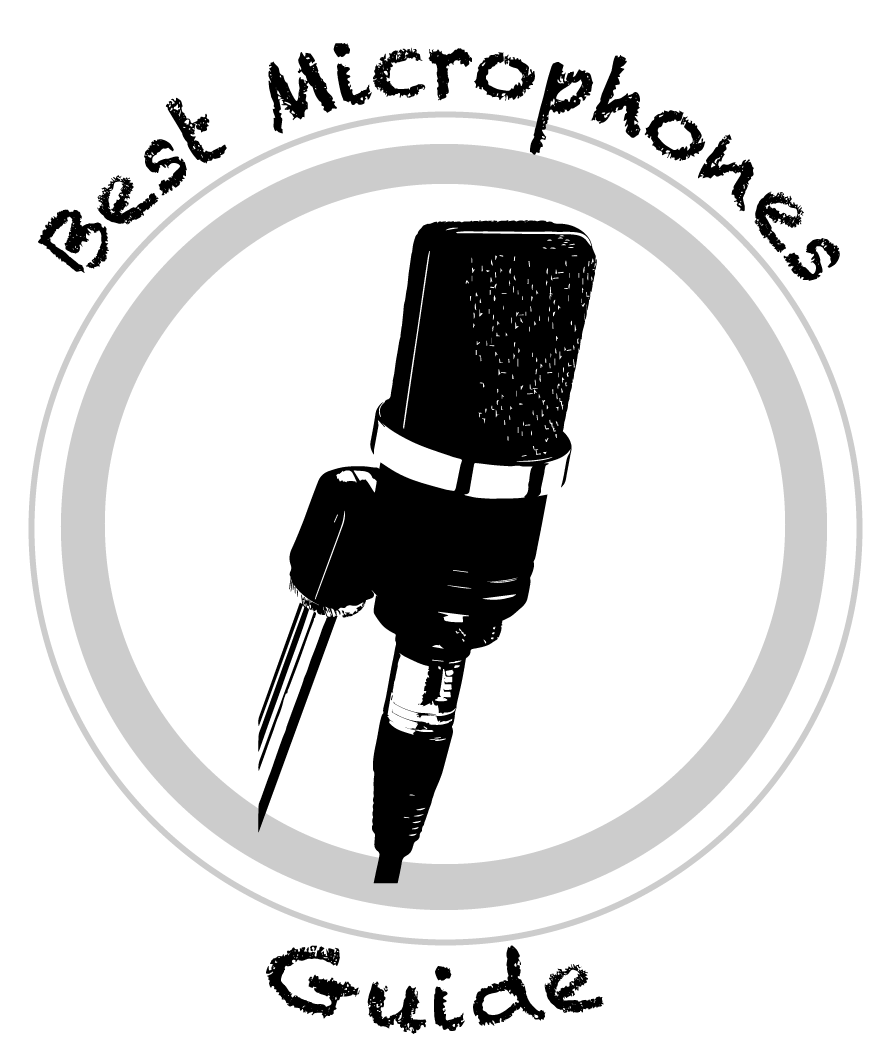Shure PGA56 Microphone Review:
A Snare and Tom Mic that Can Help You Mic Your Drum Set at an Affordable Price
As an Amazon Associate, I earn from qualifying purchases at no additional cost to you.
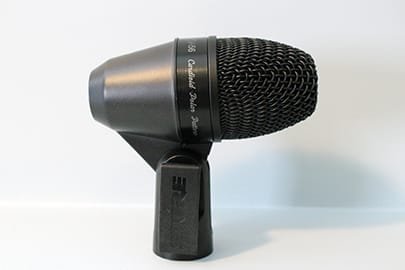
The Shure PGA56 cardioid dynamic microphone is a budget-friendly snare drum and tom microphone that can be used for live performance or for home studio recording.
It comes as a stand alone mic or alternatively is included in several drum mic packages from Shure.
A Brief History of the Shure PGA56 Microphone
As we try to do with all our reviews, let’s begin this Shure PGA56 review with a little history.
Shure released the PG Alta line of microphones in early 2015. Shure’s goal with the PG Alta product line was to provide entry level microphones that still offered Shure’s high quality engineering at a “budget conscious price.”
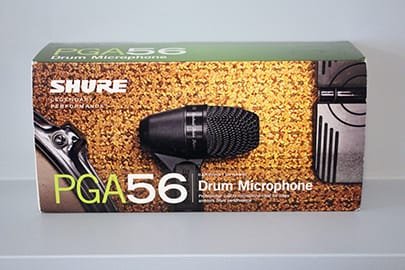
The PG Alta microphone family was launched with 10 individual microphones as well as 3 drum kit mic packages.
Shure abbreviates PG Alta to PGA.
The Shure PGA56 was included in this initial 2015 launch. It also formed the backbone of 2 of the 3 drum mic packages. Both of these drum mic packages included 3 PGA56 microphones.
From the start, the Shure PG56 was billed as a “snare / tom microphone.”
Notable Features of the Shure PGA56 Microphone
Next up in our Shure PGA56 review, let’s discuss the key features of the mic.
The Shure PGA56 is a dynamic microphone with a cardioid polar pattern. It is designed for the close miking of percussion and specifically for snare drum and toms.
The mic has a frequency response range of 50Hz to 15,000 kHz.
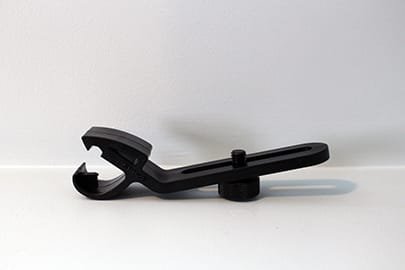
The PGA 56 has an XLR microphone connection.
It comes with a drum microphone mount, allowing you to mount it to a drum rim without needing to buy an extra microphone stand. We have seen some comments that the mount is not the highest quality or that it is hard to attach it.
While it certainly could be higher quality, the quality level is comparable to, for example, the mount on the Sennheiser e604 mics. It also attaches similarly. Simply align the top first and then wrestle with the bottom and snap it into place.
The PGA56 also has a quick release lever allowing you to quickly adjust its positioning.
Shure describes the appearance of the mic as “industrial.” Whatever that phrasing means, while the mic is perfectly fine looking, it is definitely not “beautiful.”
Recording Snare Drum
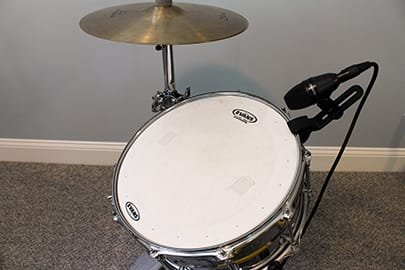
The included mount makes it easy to set up for recording rather than having to set up another stand.
The Shure PGA56 was an interesting case on the snare drum. Our first listen, which was sort of a snap judgement type situation, had us thinking that we weren’t sure whether we liked it.
When we went back and listened to it more carefully later on, we decided it sounds pretty good, especially for the price.
It depends also what we are trying to compare it to and what sound on the snare drum you are looking for. If you are looking for the classic tight snap that the Shure SM57 provides, then you aren’t going to get that with this mic.
However, if you are looking for a different sound or not attached to the SM57 sound then this could work well for you.
The PGA56 has a brighter sound than the SM57. The snare drum sound you capture will be more of a bright, crisp, and lively sound. It is also a bit more of a fuller sound compared to some other (non-SM57) options. Overall it had good attack and captured nice detail for drum rolls.
We also tested its ability to reject bleed from the hi hat vs. several top snare microphones. We found that the Shure PGA56 performed on par with these other mics in how well it rejected bleed from the hi hat.
Recording Toms
The Shure PGA56 did a nice job recording tom drums. It had a natural, warm sound without much coloration. The sound it captured was comparable to the Shure SM57, but perhaps with a slight bit more attack than the SM57.
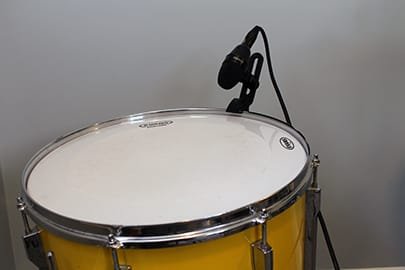
The PGA56 picked up some of the extra resonance and reverberation of the tom drum, but not too much. Sort of a “just right” amount of it.
As with the snare drum, the included drum mount was very handy in miking the toms. With all the cymbal stands and other hardware already all around a drum set, reducing the number of stands is not only cost effective but really reduces the clutter around the drum set.
If you are interested in this mic for tom drums, it is definitely worth considering. It does a good job and the price is right, especially if you want 3 of them for your toms. As mentioned elsewhere in this Shure PGA56 review, the drum mic kits Shure sells that include this mic are also worth considering and cost effective.
Live Performance
While reviewing the Shure PGA56 mic, we would be remiss if we didn’t dismiss what it can do for you in live performance use.
The Shure PGA56 mic can get you going in miking your drum kit for live performance.
As a dynamic cardioid microphone, it will reject some bleed from other sound sources on stage. Designed as a drum mic, it is intended to handle loud SPL (sound pressure levels) making it suited to the stage.
It also has a sturdy and rugged design that will help it thrive on stage, in band practice, or on the road.
The included drum mounts will help minimize on stage clutter by reducing the number of stands around the drum set.
The Shure PGA56 is a solid choice for miking snare drum and toms for live performance, especially for those on a budget.
Value and Other Alternatives
Value is an important consideration in looking at the Shure PGA56 for a review. Shure literally markets the mic as being an “entry level” and “budget conscious” option that tries to tap into the professional quality sound of Shure microphones.
So let’s explore the budget angle a little bit in detail.
Miking a drum kit requires some skill. It also requires some money if you are doing this in a home studio or for live performance. Why? Because to mike a drum set you need a minimum of 4 mics (Glyns Johns Method) and ideally quite a few more than that (8+). And all those mics cost money. Also, the mic stands take up space if you don’t have a lot of room.
Note that if doing recording, you will also be constrained by how many inputs your audio interface has available.
So it’s not just a question of buying one mic and trying to make sure it is a good one. You need to buy a number of mics. So the value proposition comes into play even more than it might with vocals or other instruments.
Currently (could always change), the mic is priced at around $69. The classic snare mic, the Shure SM57 (which recently had a price increase) is currently priced around $40 higher ($109). So that is one consideration if you are looking mainly at the snare. Do you want to spend $40 more and get the classic mic (which also has other uses)?
However, it is not quite as simple as that. Why? Because the SM57 will need a stand (more money) whereas the PGA56 comes with the attachable clip. Every mic stand you have to buy is more money spent.
Another well-known snare mic, the Audix i5, is often sold for a shade under $100.
Is there a cheaper mic than the PGA56 that is worth considering for snare? Nothing that stands out anyway.
For the toms, there are some nice mics that come with the attachable clip. However, the Sennheiser e604 is over double the price of the Shure PGA56. The Earthworks DM20 is even more expensive. So once again, the PGA56 is providing nice value.
One other option that makes sense for many people trying to mike drums is to buy a drum mic kit. There are drum mic kits available from many companies including Shure and Audix.
Shure does have other drum mic kits available including some that are SM57 heavy. However, they do offer some more affordable kits that utilize the PG Alta microphone line.
The PGA56 is included in both a 7 piece drum mic kit from Shure as well as a 5 piece drum mic kit. These might be worth checking out as well.

(commissions earned)
Shure PGA56 Review Conclusion
For its intended purpose, namely, an entry level drum microphone at an affordable price that still provides Shure quality, the Shure PGA56 delivers.
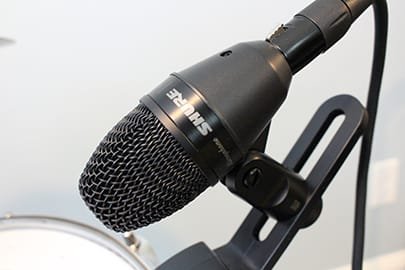
The drum mount is a real benefit and factors into the value proposition vs. buying a different mic as well as a mic stand. The Shure SM57 is a consideration for those who wish to spend a bit more and either have a mic stand for it or are willing to buy one. Higher end mics that are great for drums such as the Sennheiser MD421-II are probably not a consideration if you are looking at the PGA56.
It’s not a high end mic and it doesn’t perform like one. But it does a reasonably good job and especially for the price. If you are starting out at trying to get your drum set miked for recording or for live performance and you are on a budget while trying to buy the many mics needed for the task, the Shure PGA56 is worth a look.
Other Resources
Shure PG Alta Overview Video and PGA56 Info Page
